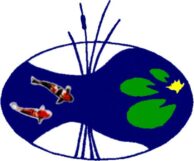Koi, or Nishikigoi ( Cyprinus carpio), are descendents of the common carp. In nature they are brown, but through selective breeding by the Japanese, numerous colors and patterns were developed. In the 17th century Chinese rice farmers began keeping carp in their rice paddies. This practice found its way to Japan. The Japanese rice farmers begin to notice slight color variations in a few of the carp and bred these “mutants” into what eventually became what we now know as koi.
It wasn’t until early in the 20th century that koi left Japan and were raised in Europe and eventually North America.
Koi normally attain lengths of approximately 2 to 3 feet and weight up to 35 lbs. Because of their large size, they should only be kept in large ponds of at least 1000 gallons. Koi need very good water quality to remain healthy. Sophisticated filtration systems should be used to maintain this water.
Koi that have been well cared for have a life expectancy of around 50-70 years and have been known to live to be over 200 years old.
Japanese Koi Terms Defined
- Ai – blue
- Aka – red
- Bu – size classification
- Budo – purple
- Cha – brown
- Doitsu – German scale, these are either completely scaleless or have rows of large scales along the dorsal and lateral lines
- Gin – silver
- Hi – red
- Kana – male koi
- Ki – yellow
- Kin – gold
- Mena – female koi
- Midori – green
- Nezu – gray
- Orenji – orange
- Shiro – white
- Sumi – black
- Tategoi – small koi with potential
Color Patterns Classified by Japanese Names
Koi can be found in just about any combination of colors. While the average koi keeper simply seeks out the koi that they are most attracted to, many hobbyists seek out specific color patterns. These many color patterns are classified by Japanese names. This list gives some of the more notable patterns.
- Asagi – body has blue-gray reticulated scales with a red underside and red in the pectoral fins. The head should be an unblemished pale blue.
- Bekko – koi with red, yellow, or white background with black spots running down the back.
- Goshiki – literally meaning five colors (white, red, black, blue, and dark blue.) Usually a white body with blue reticulated scales which is overlain with a pattern similar to a kohaku or sanke.
- Hariwake – platinum body with patterns of orange or yellow.
- Kawairmono – this is a term for recognized patterns that do not fall under one of the major pattern types.
- Kohaku – white body with patterns of red
- Koromo – white body with blue or black pinecone scales over red patterns
- Kumonryu – doitsu koi, white body with patterns of black
- Matsuba – pinecone pattern over whole body
- Ogon – solid color koi
- Sanke – white body with patterns of red and black, there can be no black on the head.
- Showa – black body with patterns of white and red
- Shusui – doitsu koi, white body with blue scales along dorsal line and a red underside
- Tancho – solid white body with a red circle on the head.
